In our community spotlight, we celebrate the remarkable success stories of local dogs who have excelled in math training. Through engaging and interactive methods, these dogs have learned to recognize numbers and solve simple problems, showcasing their enhanced cognitive skills while deepening their connection with their owners. Join us as we explore these inspiring tales of achievement and the benefits of dog math training.

What are local dog math training success stories?
Local dog math training success stories highlight the achievements of dogs and their owners in mastering basic mathematical concepts through engaging training methods. These stories showcase how dogs can learn to recognize numbers, solve simple problems, and respond to mathematical commands, enhancing their cognitive skills and strengthening the bond with their owners.
Case study: Max’s math skills in San Diego
Max, a three-year-old Golden Retriever from San Diego, has become a local sensation for his impressive ability to solve basic addition problems. His owner, Sarah, utilized positive reinforcement techniques, rewarding Max with treats for correct answers. This approach not only made learning fun for Max but also helped him associate numbers with actions.
During training sessions, Sarah would present Max with a series of objects and ask him to “count” them by pawing at the correct number of items. Over a few months, Max progressed from simple tasks to more complex equations, demonstrating his understanding of addition and subtraction by responding accurately to Sarah’s cues.
Case study: Bella’s training journey in Austin
Bella, a two-year-old Border Collie in Austin, has shown remarkable progress in her math training, particularly in recognizing patterns and sequences. Her owner, Mike, focused on interactive games that involved arranging toys in specific numerical orders, which helped Bella grasp the concept of sequencing.
To enhance Bella’s skills, Mike incorporated outdoor activities, such as using sticks to create number shapes on the ground. This hands-on approach kept Bella engaged and allowed her to practice her math skills in a dynamic environment. As a result, Bella not only improved her cognitive abilities but also enjoyed her training sessions, making the process enjoyable for both her and Mike.
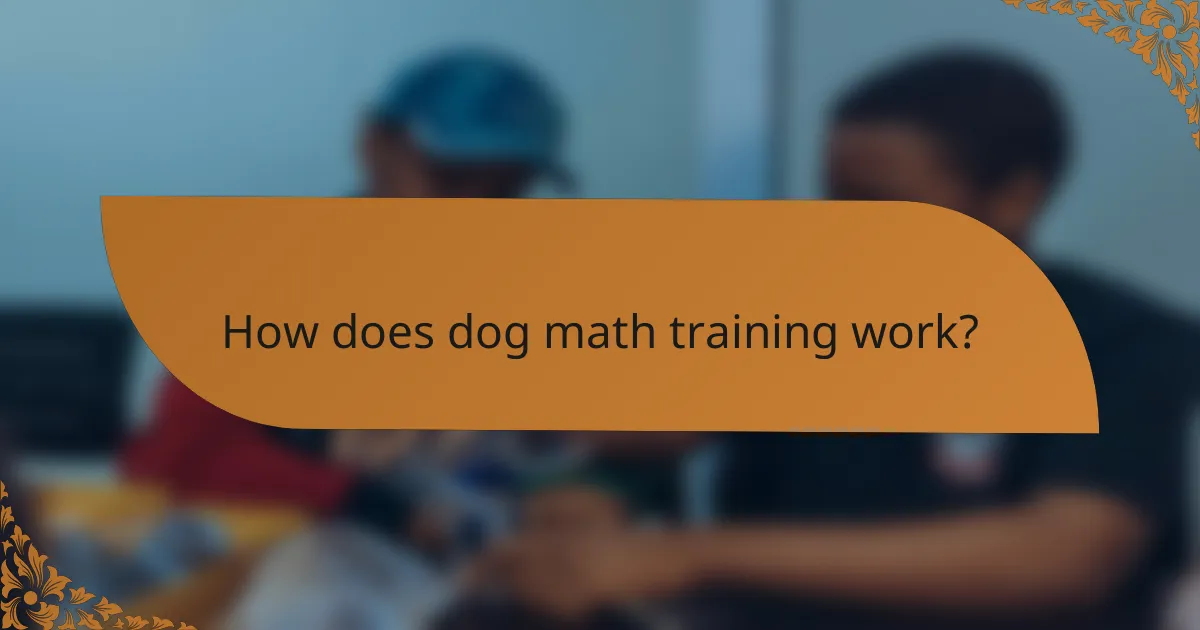
How does dog math training work?
Dog math training teaches dogs to understand basic mathematical concepts through interactive exercises. This method combines physical activities with cognitive challenges, allowing dogs to learn through play and repetition.
Basic principles of dog math training
The foundation of dog math training lies in positive reinforcement, where dogs receive rewards for correct responses to mathematical tasks. This can include simple operations like addition and subtraction, using treats or toys as incentives.
Another principle is consistency; training sessions should be regular and structured to help dogs grasp concepts effectively. Short, frequent sessions are often more beneficial than longer, infrequent ones, keeping the dog engaged and focused.
Techniques used in local training programs
Local training programs often employ techniques such as clicker training, where a click sound marks the correct behavior, followed by a reward. This method helps dogs associate their actions with positive outcomes, reinforcing their learning.
Additionally, visual aids like colored mats or numbered toys can enhance understanding. For example, placing two toys on one mat and one on another can visually demonstrate the concept of addition. Trainers may also use group activities to foster social learning among dogs.
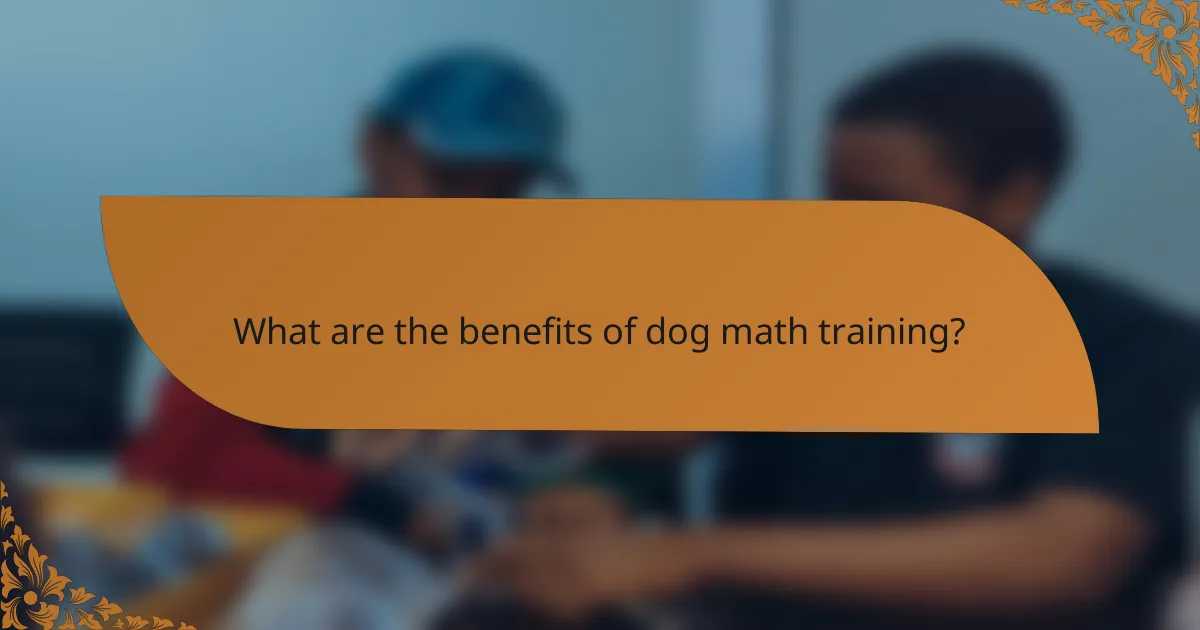
What are the benefits of dog math training?
Dog math training offers numerous advantages, including enhanced cognitive abilities and stronger bonds between dogs and their owners. This innovative approach helps dogs learn basic math concepts, which can improve their overall mental agility and responsiveness.
Enhanced cognitive skills for dogs
Dog math training stimulates mental activity, encouraging dogs to engage in problem-solving tasks. This can lead to improved focus, memory, and decision-making skills. For instance, teaching a dog to recognize the difference between quantities can enhance their ability to understand commands and respond appropriately.
To implement this training, start with simple exercises, such as using treats to demonstrate addition or subtraction. For example, place two treats in one bowl and one in another, then ask your dog to choose the bowl with more treats. Gradually increase the complexity as your dog becomes more adept.
Improved owner-dog bonding
Engaging in dog math training fosters a deeper connection between owners and their pets. The interactive nature of the training sessions promotes teamwork and communication, which can strengthen the relationship. Dogs thrive on positive reinforcement, making training a rewarding experience for both parties.
To maximize bonding during training, ensure sessions are short and enjoyable, lasting around 5 to 10 minutes. Use praise and treats to encourage your dog, and avoid frustration by being patient and consistent. This positive approach not only enhances learning but also builds trust and affection between you and your dog.
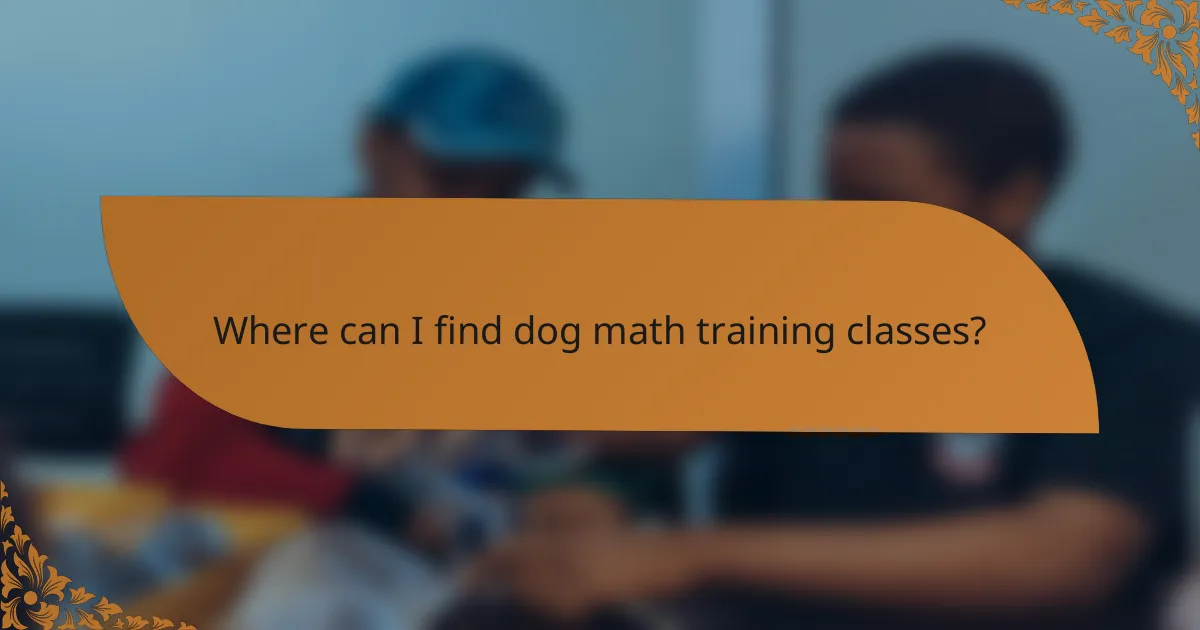
Where can I find dog math training classes?
Dog math training classes can be found at various local training facilities, pet stores, and online platforms. Look for programs that specialize in teaching dogs to solve basic math problems through positive reinforcement techniques.
Top-rated trainers in Los Angeles
In Los Angeles, several trainers are recognized for their effective dog math programs. Notable names include Canine Academy and Pawsitive Solutions, both offering classes that emphasize interactive learning and fun exercises.
When selecting a trainer, consider their experience, training methods, and student reviews. Many trainers offer introductory sessions, allowing you to assess their approach before committing.
Recommended programs in New York City
New York City boasts a variety of dog math training programs, with Bark University and The Dog Training Center being among the most recommended. These programs often incorporate engaging activities that help dogs learn math concepts in a playful environment.
Check for class schedules and pricing, as they can vary significantly. Many programs offer tiered levels of training, so you can choose one that matches your dog’s current skills and learning pace.
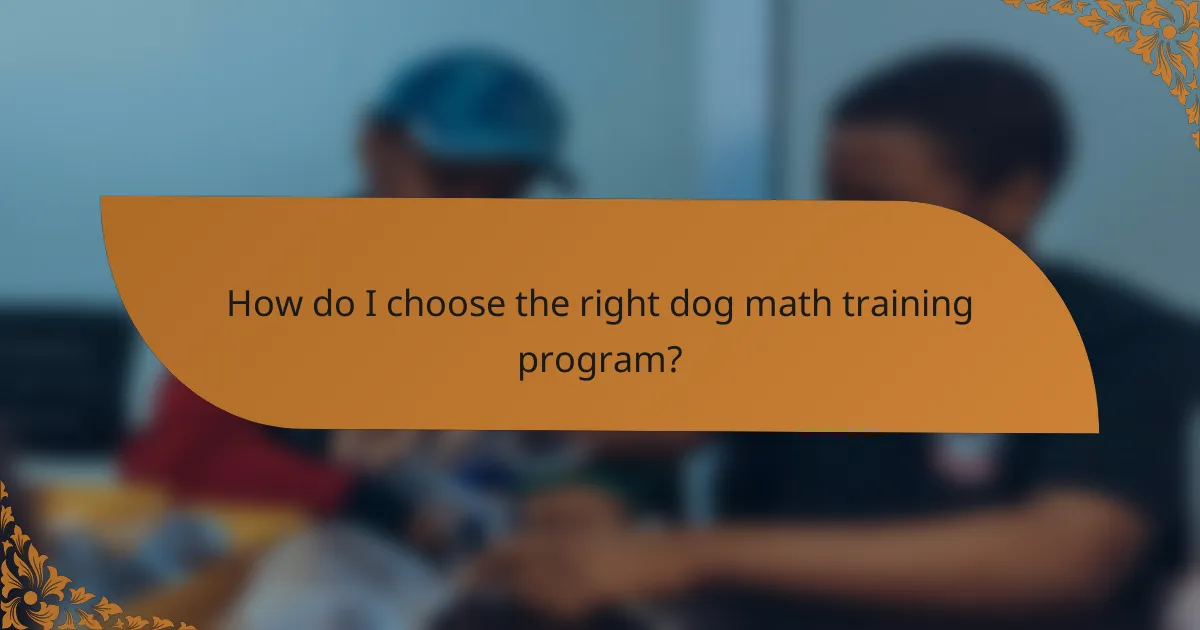
How do I choose the right dog math training program?
Choosing the right dog math training program involves assessing your dog’s specific needs and the trainer’s qualifications. Look for programs that offer a structured curriculum, positive reinforcement techniques, and a good reputation in your community.
Criteria for selecting a training program
When selecting a training program, consider the trainer’s experience and credentials. Look for certifications from recognized organizations, such as the Association of Professional Dog Trainers (APDT) or the International Association of Animal Behavior Consultants (IAABC).
Evaluate the training methods used. Programs that emphasize positive reinforcement are generally more effective and humane. Check if the curriculum includes a variety of skills, such as basic math commands and problem-solving exercises.
Lastly, consider the program’s location and schedule. Choose a program that fits your availability and is easily accessible. Many trainers offer both in-person and online options, which can provide flexibility.
Questions to ask potential trainers
Before enrolling, ask potential trainers about their experience with dog math training specifically. Inquire about their success stories and how they measure progress in their students.
It’s also important to understand their training philosophy. Ask how they handle behavioral issues and what techniques they use to ensure a positive learning environment.
Finally, request references from previous clients. Speaking with other dog owners can provide insights into the trainer’s effectiveness and the overall satisfaction with the program.
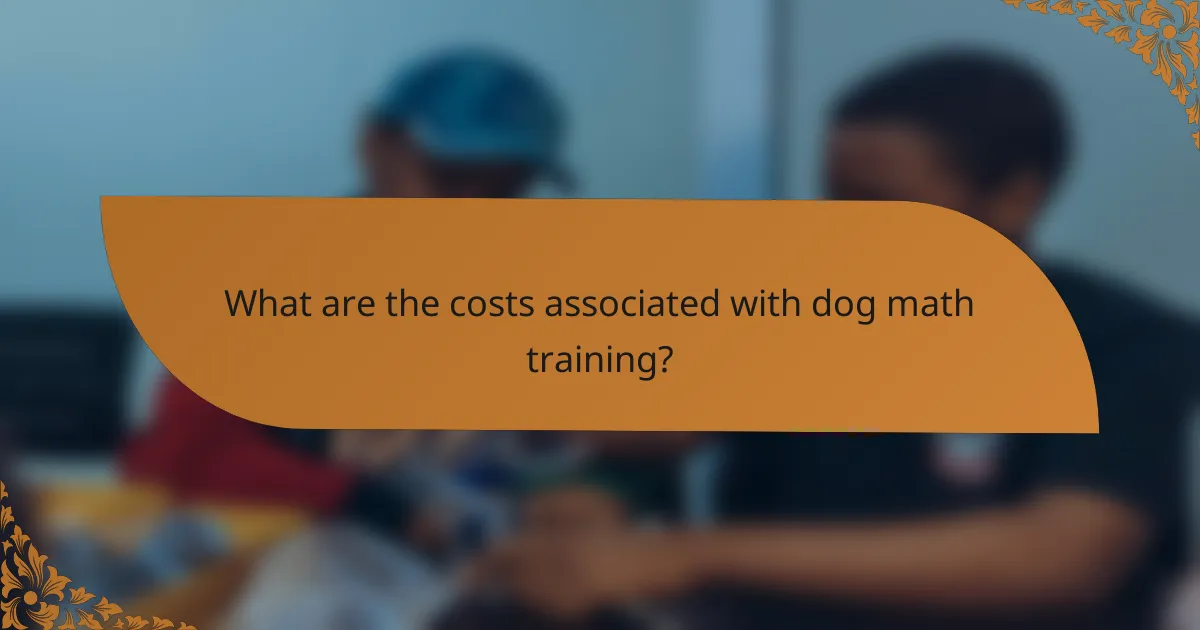
What are the costs associated with dog math training?
The costs associated with dog math training can vary widely based on several factors, including location, class type, and duration. Generally, pet owners can expect to invest anywhere from a few dozen to several hundred dollars for comprehensive training programs.
Average pricing for local classes
In many regions, local dog math training classes typically range from $50 to $200 for a series of sessions. Group classes are often more affordable, averaging around $100 for a six-week course, while private sessions can cost between $75 and $150 per hour. Some facilities may offer package deals that provide discounts for multiple sessions.
Factors affecting training costs
Several factors can influence the overall cost of dog math training. The trainer’s experience and credentials play a significant role; more experienced trainers may charge higher rates. Additionally, the type of training—whether group classes, private lessons, or specialized workshops—will impact pricing.
Location is another important consideration. Urban areas often have higher costs due to increased demand and overhead expenses. Furthermore, the duration and frequency of classes can affect total costs; longer or more frequent sessions typically lead to higher overall expenses.

What tools and resources enhance dog math training?
Effective dog math training relies on a variety of tools and resources that facilitate learning and engagement. Utilizing apps, books, and interactive materials can significantly improve a dog’s ability to understand basic math concepts through consistent practice and positive reinforcement.
Recommended training apps and tools
Several apps and tools are designed specifically for dog training, including math concepts. Popular choices include “PawMath,” which offers interactive games that teach dogs to recognize numbers and perform simple calculations through fun challenges.
Additionally, using clickers and treat dispensers can enhance the training experience. Clickers help mark correct behaviors instantly, while treat dispensers can reward dogs for completing math tasks, reinforcing their learning through positive feedback.
Books and materials for dog math training
Books such as “Canine Calculations” provide structured lessons and exercises for teaching dogs math skills. These resources often include step-by-step instructions and real-life examples that make it easier for trainers to implement lessons effectively.
Incorporating visual aids like flashcards can also be beneficial. Flashcards with numbers and simple math problems can be used during training sessions to reinforce learning and keep the dog engaged. Aim for short sessions of around 5-10 minutes to maintain focus and enthusiasm.

What are common challenges in dog math training?
Dog math training often faces challenges such as inconsistent behavior, distractions, and varying learning speeds among dogs. These factors can hinder progress and make it difficult for trainers to achieve desired outcomes.
Inconsistent behavior in dogs
Inconsistent behavior is a common hurdle in dog math training. Dogs may respond differently to commands based on their mood, environment, or level of distraction. This unpredictability can lead to confusion for both the dog and the trainer.
To address this, establish a consistent training routine and use the same commands and cues. Rewarding positive behavior promptly can reinforce learning and help dogs understand what is expected of them.
Distractions during training sessions
Distractions can significantly impact a dog’s ability to focus during math training. Noisy environments, other animals, or even tempting scents can divert a dog’s attention away from the task at hand.
To minimize distractions, choose a quiet training location and gradually introduce distractions as the dog becomes more proficient. Using high-value treats can also help maintain focus during challenging sessions.
Varying learning speeds among dogs
Dogs learn at different rates, which can be frustrating for trainers. Some dogs may grasp concepts quickly, while others may take longer to understand the same tasks. This variance can affect group training sessions and individual progress.
To accommodate different learning speeds, consider personalized training plans that cater to each dog’s unique needs. Patience and positive reinforcement are key; celebrate small victories to encourage continued effort and engagement.
